Commentary
Article
Dr David Eagle: CMS Reimbursement Cuts Encourage Trend of Independent Physician Exodus
Author(s):
Over the past 20 years, Medicare physician pay has plummeted by 26% when adjusted for inflation, while hospital reimbursement has surged by 70%, prompting over 100,000 doctors to abandon independent practice for hospital or corporate employment since 2019.
For independent doctors, 2024 began with a Medicare reimbursement pay cut of 3.4%, as legislation in both the House and Senate seeks to alleviate but not eradicate the reduction. Over the past 20 years, Medicare physician pay has plummeted by 26% when adjusted for inflation, while hospital reimbursement has surged by 70%, prompting over 100,000 doctors to abandon independent practice for hospital or corporate employment since 2019.
According to David A. Eagle, MD, of New York Cancer & Blood Specialists, this is a threat to patient access and care quality. In an interview with The American Journal of Managed Care® (AJMC®), he discusses how the expenses associated with practicing medicine have risen by 50% since 2001, rendering it increasingly difficult for independent physicians to sustain their operations.
David A. Eagle, MD

AJMC: Can you provide an overview of the current situation regarding the proposed 3.4% Medicare reimbursement pay cut for independent doctors effective January 1?
Eagle: Yeah, unfortunately, it's gone from proposed to actually being implemented. We still are hoping for a fix but it looks like that won't happen until March of this year if the legislators can agree on a fix. So, unfortunately, those cuts have already happened. You know, 3.4%, by itself, doesn't necessarily sound like a whole lot, but it is in the context of repeated cuts and lack of inflation adjustments that have occurred for the last 20 years.
AJMC: In contrast, the reimbursement for hospitals has seen a 70% growth. How has this discrepancy impacted the choices of physicians between independent practices and larger health care systems?
Eagle: Yeah, unfortunately, we've seen a decline in independent practices that began 40 years ago and continues today. You know, 40 years ago, approximately three-quarters of physician practices were independent, and now it’s probably a quarter of practices that are truly independent. And that's largely a result of the reimbursement changes—if you have one system that's supported with higher reimbursement, it's not surprising that the providers in the care would migrate to that more expensive system. So, you know, we think that's what needs to be rectified.
The inflation changes have been a problem now for 20 years and the hospitals and other facilities get automatic inflation adjustments in their reimbursement and private physicians do not. And it's the fact that that has gone on for so long, it’s created just a huge discrepancy with the financial support that goes to private physician offices versus hospitals.
AJMC: Could you elaborate on the trends in Medicare physician pay over the past 2 decades, particularly the 26% decrease when adjusted for inflation? What factors have contributed to this decline?
Eagle: I think it's the fact that if we look at it, physician reimbursement has gone up just 10% since 2001. While hospital payment has gone up 70% since that time, and it's a combination of the inflation adjustments, and the actual changes in the [fee] schedule itself, that both of those things together have just created a divergence. And I think a lot of people have seen the graphs of the divergence between physicians and hospitals since that time. And you know, when you make those small changes over a longer period of time, it adds up, and it actually impacts the settings of care that patients have access to.
AJMC: The statement mentions over 100,000 doctors leaving independent practice since 2019. What are the main reasons behind this exodus, and how has it affected the quality of patient care?
Eagle: Well, we think that independent medicine provides tremendous value and quality for patients, and allows people to get treated in their local communities in a more convenient setting and a more cost-efficient setting. And I think typically, the out-of-pocket expenses for patients are lower as well. So we believe in that independent model and we believe that it really serves patients well, it really just comes down to reimbursement and we have to compete with other models of care. If our reimbursement goes down while there are other competing models of care that reimbursement goes up, that just makes it harder to maintain independent physician practices.
AJMC: The cost of practicing medicine has reportedly increased by 50% since 2001. What are the primary cost drivers, and how does this impact the ability of independent physicians to sustain their practices?
Eagle: Just the cost of everything from rent to particularly, personnel, staff salaries, all that's gone up over the past 20 years, while physician payments have been relatively flat. So, at some point maintaining an independent practice the numbers don't pencil out when the costs go up, but the reimbursement doesn't.
AJMC: How have both the House and Senate been addressing this issue through legislation, and what are the key considerations in those proposals?
Eagle: We very much support the Strengthening Medicare for Patients and Providers Act, HR 2474, that was introduced last year. That provides permanent inflation-based updates to the Medicare Physician Fee Schedule and eliminates the payment cut that took effect at the beginning of 2024. So we think that's the exact type of legislation that needs to be supported to address these issues.
AJMC: How does this shift from independent care to hospital care settings affect health care access and equity for patients?
Eagle: Well, I can give an example, our practice in New York and Long Island, we take all insurance plans, we put clinics in locations that, frankly, in communities that other cancer providers don't necessarily want to go to. So the first step is to be available for the patient in their community, where they can come see you, and actually take their insurance plan. And if you can't do that you can't offer hope to patients. The hospital-based care sometimes just isn't available for patients. And then oftentimes, the out-of-pocket costs for hospital care, which includes some things like facility fees can be higher. So that can be a barrier for patients.
At New York Cancer and Blood, one of the things we're really trying to do is build out a structured health-related social needs intake form so we can better connect patients in need with resources. We have our own in-practice foundation, that raised over a million dollars last year, and we use those resources to actually try to meet the needs of patients who have financial needs—their non-medical needs. So that's for transportation, housing, utilities, food, those types of things. Those are the types of things as private practice, we try to focus on and provide care for the benefit of the patient or community. But to your original question, you know, to really take care of a patient, you have to be in a location that they could get to, and you have to accept their insurance plan, and without that, they just don't have access to you.
AJMC: Are there any legislative actions where there could be potential solutions or strategies that could be explored to support independent physicians and mitigate the challenges they face?
Eagle: I think payment parity legislation could help. I think anytime that you have 2 separate models of care that pay differently for providing the same type of service, I think that type of payment disparity really is the type of thing that puts more pressure on independent medicine. Supporting payment parity between private physician offices and hospitals would be a very good, important step in the right direction.
AJMC: The statement suggests that care costs more at hospitals and large systems. Can you explain why this is the case and how it contributes to the overall health care landscape?
Eagle: Well, I think patient out-of-pocket expenses are often higher, the hospitals are paid under a different method by Medicare compared with private physician offices. So there are things like facility fees, the hospitals can often negotiate higher commercial rates with the private insurers. And I think often that that translates into patients paying higher co-pays when they seek care in the hospital. I think the care itself is actually more expensive, too, because the hospitals tend to be structurally more expensive than private physician offices.
AJMC: How can the health care system strike a balance between controlling costs and ensuring quality care delivery, particularly in the context of independent practices?
Eagle: I think the best way to strike the balance between cost in quality is to support the lowest-cost providers of care that provide the quality. And I think independent practices do do that. I think our quality is as good as if not better than care in the hospital setting. And we can do it at a lower cost. So I think supporting that model is really the best way to strike that balance.
AJMC: Do you have anything else to add?
Eagle: We have a new organization, the American Independent Medical Practice Association, and that really looks to be the voice for independent medicine, and that independent medicine needs its own voice. We've launched this organization to do that and to help share the message: It is getting harder for medical practices to stay independent, and there's tremendous value to the patients of private physician offices. Patients should have that option.

Navigating Sport-Related Neurospine Injuries, Surgery, and Managed Care




